2007 ISUZU KB P190 engine oil
[x] Cancel search: engine oilPage 1697 of 6020
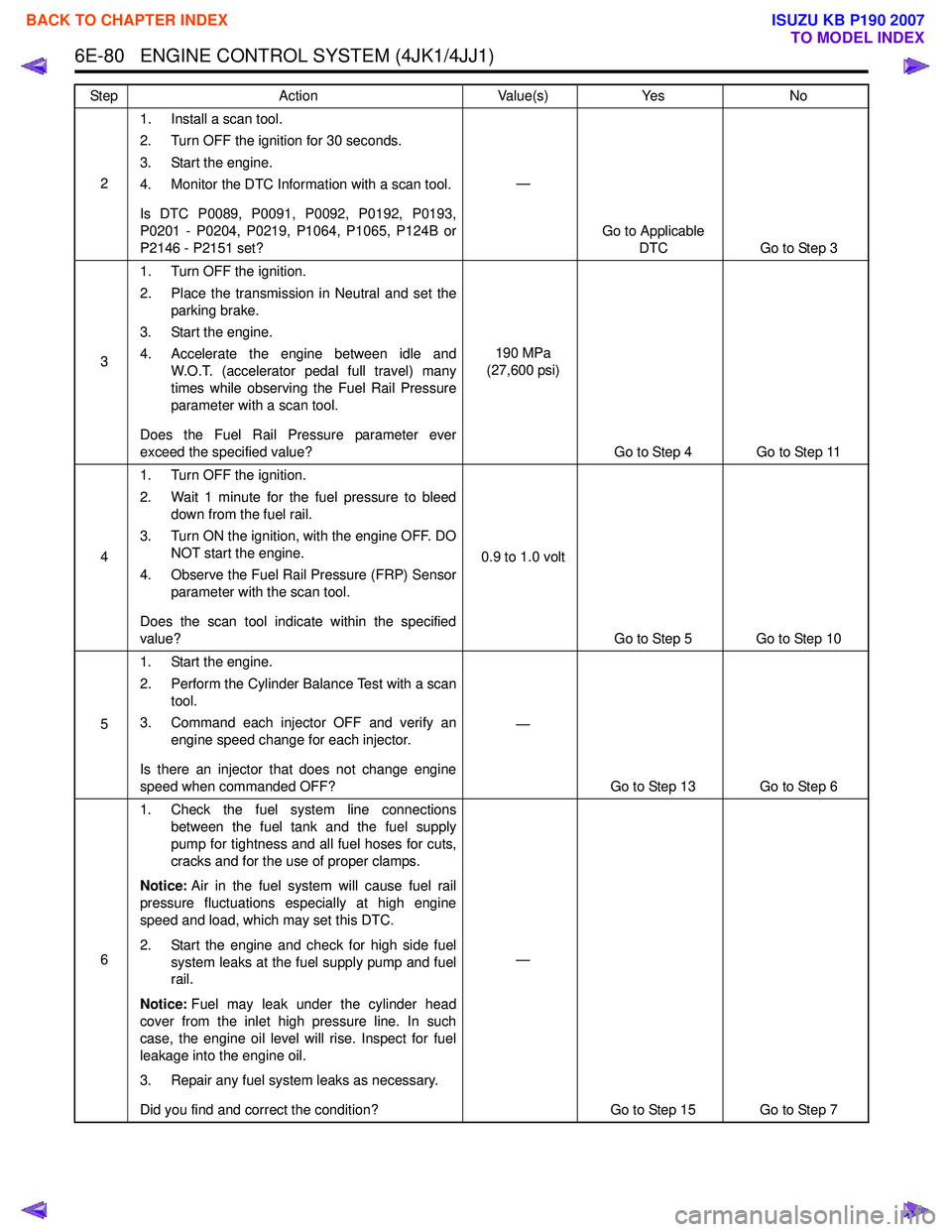
6E-80 ENGINE CONTROL SYSTEM (4JK1/4JJ1)
21. Install a scan tool.
2. Turn OFF the ignition for 30 seconds.
3. Start the engine.
4. Monitor the DTC Information with a scan tool.
Is DTC P0089, P0091, P0092, P0192, P0193,
P0201 - P0204, P0219, P1064, P1065, P124B or
P2146 - P2151 set? —
Go to Applicable DTC Go to Step 3
3 1. Turn OFF the ignition.
2. Place the transmission in Neutral and set the parking brake.
3. Start the engine.
4. Accelerate the engine between idle and W.O.T. (accelerator pedal full travel) many
times while observing the Fuel Rail Pressure
parameter with a scan tool.
Does the Fuel Rail Pressure parameter ever
exceed the specified value? 190 MPa
(27,600 psi)
Go to Step 4 Go to Step 11
4 1. Turn OFF the ignition.
2. Wait 1 minute for the fuel pressure to bleed down from the fuel rail.
3. Turn ON the ignition, with the engine OFF. DO NOT start the engine.
4. Observe the Fuel Rail Pressure (FRP) Sensor parameter with the scan tool.
Does the scan tool indicate within the specified
value? 0.9 to 1.0 volt
Go to Step 5 Go to Step 10
5 1. Start the engine.
2. Perform the Cylinder Balance Test with a scan tool.
3. Command each injector OFF and verify an engine speed change for each injector.
Is there an injector that does not change engine
speed when commanded OFF? —
Go to Step 13 Go to Step 6
6 1. Check the fuel system line connections
between the fuel tank and the fuel supply
pump for tightness and all fuel hoses for cuts,
cracks and for the use of proper clamps.
Notice: Air in the fuel system will cause fuel rail
pressure fluctuations especially at high engine
speed and load, which may set this DTC.
2. Start the engine and check for high side fuel system leaks at the fuel supply pump and fuel
rail.
Notice: Fuel may leak under the cylinder head
cover from the inlet high pressure line. In such
case, the engine oil level will rise. Inspect for fuel
leakage into the engine oil.
3. Repair any fuel system leaks as necessary.
Did you find and correct the condition? —
Go to Step 15 Go to Step 7
Step
Action Value(s)Yes No
BACK TO CHAPTER INDEX
TO MODEL INDEX
ISUZU KB P190 2007
Page 1708 of 6020
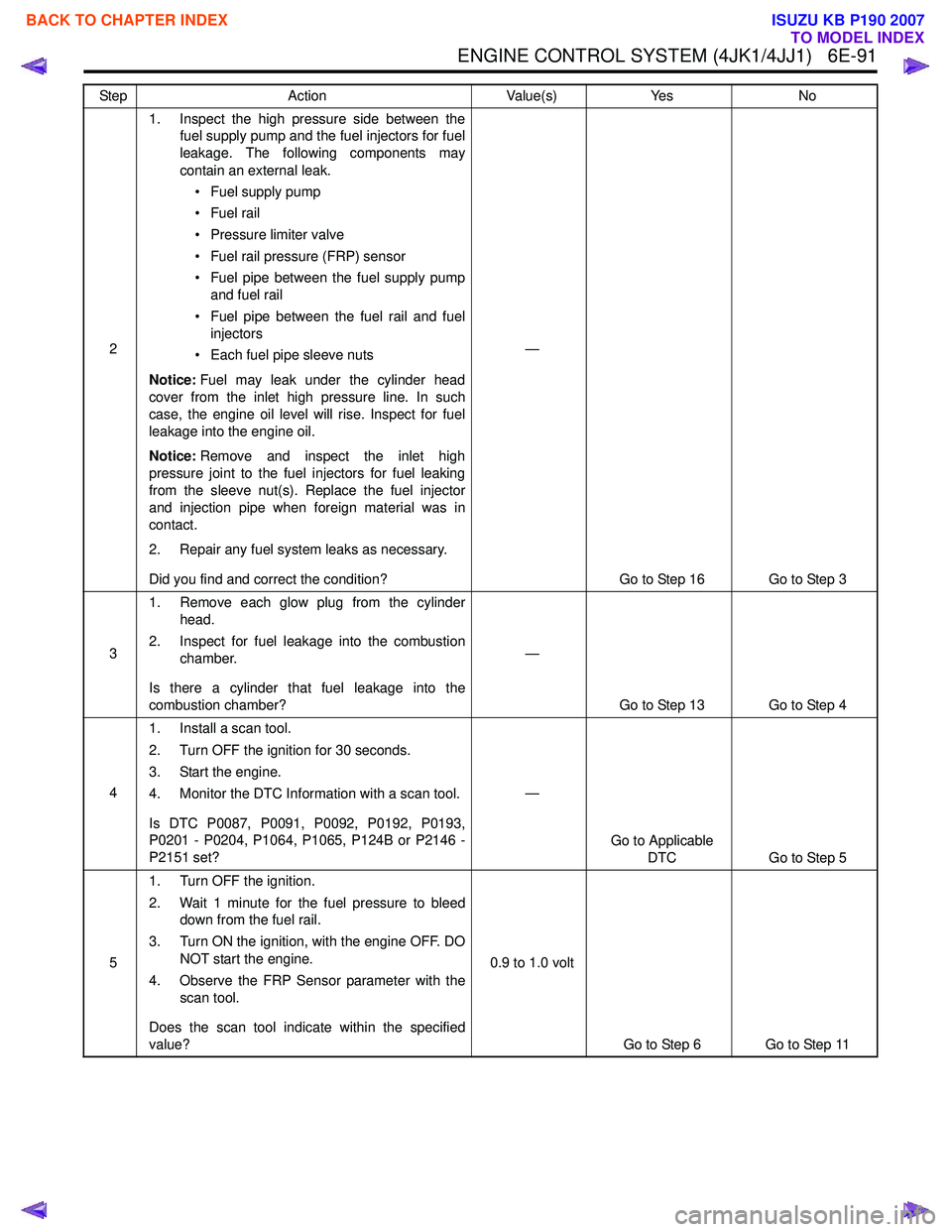
ENGINE CONTROL SYSTEM (4JK1/4JJ1) 6E-91
21. Inspect the high pressure side between the
fuel supply pump and the fuel injectors for fuel
leakage. The following components may
contain an external leak.
• Fuel supply pump
• Fuel rail
•Pressure limiter valve
• Fuel rail pressure (FRP) sensor
• Fuel pipe between the fuel supply pump and fuel rail
• Fuel pipe between the fuel rail and fuel injectors
• Each fuel pipe sleeve nuts
Notice: Fuel may leak under the cylinder head
cover from the inlet high pressure line. In such
case, the engine oil level will rise. Inspect for fuel
leakage into the engine oil.
Notice: Remove and inspect the inlet high
pressure joint to the fuel injectors for fuel leaking
from the sleeve nut(s). Replace the fuel injector
and injection pipe when foreign material was in
contact.
2. Repair any fuel system leaks as necessary.
Did you find and correct the condition? —
Go to Step 16 Go to Step 3
3 1. Remove each glow plug from the cylinder
head.
2. Inspect for fuel leakage into the combustion chamber.
Is there a cylinder that fuel leakage into the
combustion chamber? —
Go to Step 13 Go to Step 4
4 1. Install a scan tool.
2. Turn OFF the ignition for 30 seconds.
3. Start the engine.
4. Monitor the DTC Information with a scan tool.
Is DTC P0087, P0091, P0092, P0192, P0193,
P0201 - P0204, P1064, P1065, P124B or P2146 -
P2151 set? —
Go to Applicable DTC Go to Step 5
5 1. Turn OFF the ignition.
2. Wait 1 minute for the fuel pressure to bleed down from the fuel rail.
3. Turn ON the ignition, with the engine OFF. DO NOT start the engine.
4. Observe the FRP Sensor parameter with the scan tool.
Does the scan tool indicate within the specified
value? 0.9 to 1.0 volt
Go to Step 6 Go to Step 11
Step
Action Value(s)Yes No
BACK TO CHAPTER INDEX
TO MODEL INDEX
ISUZU KB P190 2007
Page 1757 of 6020
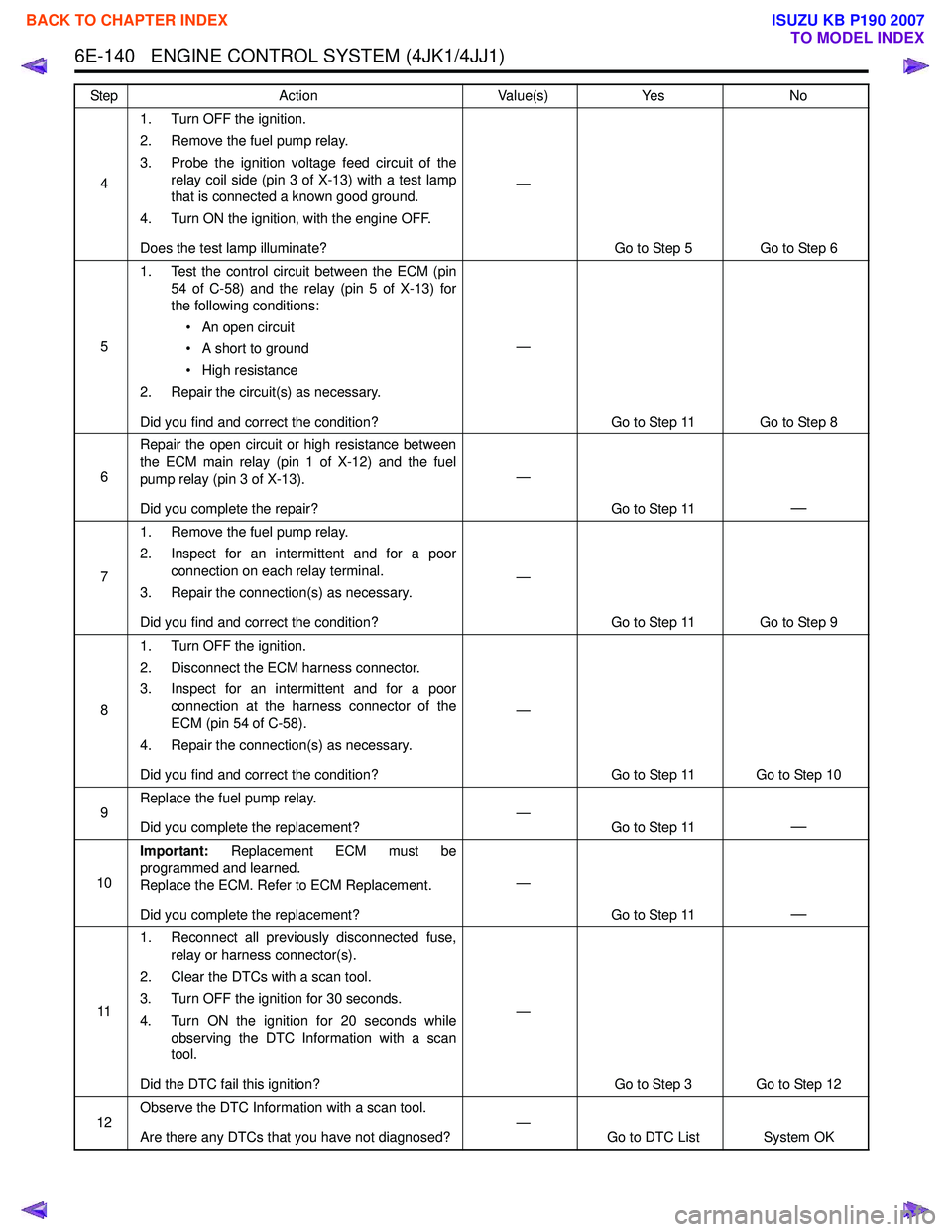
6E-140 ENGINE CONTROL SYSTEM (4JK1/4JJ1)
41. Turn OFF the ignition.
2. Remove the fuel pump relay.
3. Probe the ignition voltage feed circuit of the relay coil side (pin 3 of X-13) with a test lamp
that is connected a known good ground.
4. Turn ON the ignition, with the engine OFF.
Does the test lamp illuminate? —
Go to Step 5 Go to Step 6
5 1. Test the control circuit between the ECM (pin
54 of C-58) and the relay (pin 5 of X-13) for
the following conditions:
• An open circuit
• A short to ground
• High resistance
2. Repair the circuit(s) as necessary.
Did you find and correct the condition? —
Go to Step 11 Go to Step 8
6 Repair the open circuit or high resistance between
the ECM main relay (pin 1 of X-12) and the fuel
pump relay (pin 3 of X-13).
Did you complete the repair? —
Go to Step 11
—
71. Remove the fuel pump relay.
2. Inspect for an intermittent and for a poor connection on each relay terminal.
3. Repair the connection(s) as necessary.
Did you find and correct the condition? —
Go to Step 11 Go to Step 9
8 1. Turn OFF the ignition.
2. Disconnect the ECM harness connector.
3. Inspect for an intermittent and for a poor connection at the harness connector of the
ECM (pin 54 of C-58).
4. Repair the connection(s) as necessary.
Did you find and correct the condition? —
Go to Step 11 Go to Step 10
9 Replace the fuel pump relay.
Did you complete the replacement? —
Go to Step 11
—
10Important:
Replacement ECM must be
programmed and learned.
Replace the ECM. Refer to ECM Replacement.
Did you complete the replacement? —
Go to Step 11
—
111. Reconnect all previously disconnected fuse,
relay or harness connector(s).
2. Clear the DTCs with a scan tool.
3. Turn OFF the ignition for 30 seconds.
4. Turn ON the ignition for 20 seconds while observing the DTC Information with a scan
tool.
Did the DTC fail this ignition? —
Go to Step 3 Go to Step 12
12 Observe the DTC Information with a scan tool.
Are there any DTCs that you have not diagnosed? —
Go to DTC List System OK
Step
Action Value(s)Yes No
BACK TO CHAPTER INDEX
TO MODEL INDEX
ISUZU KB P190 2007
Page 1760 of 6020

ENGINE CONTROL SYSTEM (4JK1/4JJ1) 6E-143
4Compare the BARO value to the range specified in
the altitude vs. barometric pressure table. Refer to
Altitude vs Barometric Pressure.
Is the BARO parameter within the range specified? —
Go to Step 6 Go to Step 7
5 1. Inspect the following for possible causes of
high boost pressure.
• Misrouted turbocharger nozzle control actuator vacuum hoses
• Turbocharger nozzle control actuator or solenoid valve for a stuck condition.
Refer to Turbocharger Control System
Check in this section.
• Intake throttle valve sticking. Perform the Intake Throttle Solenoid Control with a
scan tool
• Oil in the air induction tubing causing an incorrect boost pressure sensor signal.
When there is adhesion of oil inside of
the tubing, intercooler or turbocharger it
needs to be wiped off.
2. Repair or replace as necessary.
Did you find and correction the condition? —
Go to Step 10 Go to Diagnostic
Aids
6 1. Turn OFF the ignition.
2. Disconnect the boost pressure sensor harness connector.
3. Inspect for an intermittent and for a poor connection at the harness connector of the
boost pressure sensor (pin 2 of E-107).
4. Disconnect the ECM harness connector.
5. Inspect for an intermittent, for a poor connection and corrosion at the harness
connector of the ECM (pin 23 of E-90).
6. Test for high resistance of the low reference circuit.
7. Repair the connection(s) or circuit(s) as necessary.
Did you find and correct the condition? —
Go to Step 10 Go to Step 8
7 1. Turn OFF the ignition.
2. Disconnect the BARO sensor harness connector.
3. Inspect for an intermittent and for poor connections at the harness connector of the
BARO sensor (pins 2 and 3 of E-40).
4. Disconnect the ECM harness connector.
5. Inspect for an intermittent, for poor connections and corrosion at the harness
connector of the ECM (pins 18 and 19 of E-
90).
6. Test for high resistance on each circuit.
7. Repair the connection(s) or circuit(s) as necessary.
Did you find and correct the condition? —
Go to Step 10 Go to Step 9
Step
Action Value(s)Yes No
BACK TO CHAPTER INDEX
TO MODEL INDEX
ISUZU KB P190 2007
Page 1763 of 6020
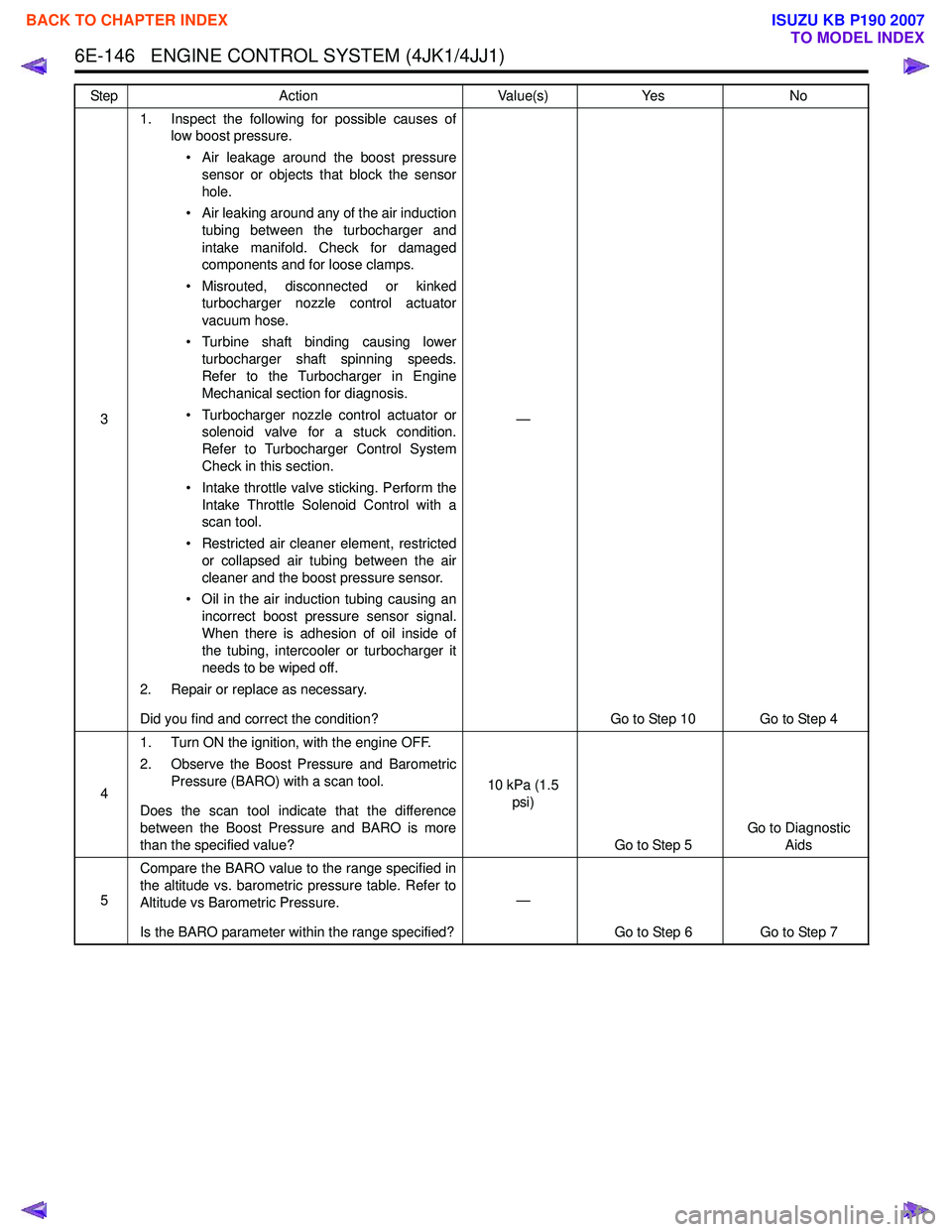
6E-146 ENGINE CONTROL SYSTEM (4JK1/4JJ1)
31. Inspect the following for possible causes of
low boost pressure.
• Air leakage around the boost pressure sensor or objects that block the sensor
hole.
• Air leaking around any of the air induction tubing between the turbocharger and
intake manifold. Check for damaged
components and for loose clamps.
• Misrouted, disconnected or kinked turbocharger nozzle control actuator
vacuum hose.
• Turbine shaft binding causing lower turbocharger shaft spinning speeds.
Refer to the Turbocharger in Engine
Mechanical section for diagnosis.
• Turbocharger nozzle control actuator or solenoid valve for a stuck condition.
Refer to Turbocharger Control System
Check in this section.
• Intake throttle valve sticking. Perform the Intake Throttle Solenoid Control with a
scan tool.
• Restricted air cleaner element, restricted or collapsed air tubing between the air
cleaner and the boost pressure sensor.
• Oil in the air induction tubing causing an incorrect boost pressure sensor signal.
When there is adhesion of oil inside of
the tubing, intercooler or turbocharger it
needs to be wiped off.
2. Repair or replace as necessary.
Did you find and correct the condition? —
Go to Step 10 Go to Step 4
4 1. Turn ON the ignition, with the engine OFF.
2. Observe the Boost Pressure and Barometric Pressure (BARO) with a scan tool.
Does the scan tool indicate that the difference
between the Boost Pressure and BARO is more
than the specified value? 10 kPa (1.5
psi)
Go to Step 5 Go to Diagnostic
Aids
5 Compare the BARO value to the range specified in
the altitude vs. barometric pressure table. Refer to
Altitude vs Barometric Pressure.
Is the BARO parameter within the range specified? —
Go to Step 6 Go to Step 7
Step
Action Value(s)Yes No
BACK TO CHAPTER INDEX
TO MODEL INDEX
ISUZU KB P190 2007
Page 1776 of 6020

ENGINE CONTROL SYSTEM (4JK1/4JJ1) 6E-159
41. Turn OFF the ignition.
2. Replace the glow relay with the starter relay or replace with a known good relay.
3. Perform the Glow Relay Control with a scan tool.
4. Command the relay ON and OFF.
Does the glow relay click with each command? —
Go to Step 8 Go to Step 5
5 1. Turn OFF the ignition.
2. Remove the glow relay.
3. Turn ON the ignition, with the engine OFF.
4. Probe the ignition voltage feed circuit of the relay coil side (pin 2 of X-5) with a test lamp
that is connected to a known good ground.
Does the test lamp illuminate? —
Go to Step 6 Go to Step 7
6 1. Test the control circuit between the ECM (pin
37 of C-58) and the relay (pin 3 of X-5) for the
following conditions:
• An open circuit
• A short to ground
• A short to battery or ignition voltage
2. Repair the circuit(s) as necessary.
Did you find and correct the condition? —
Go to Step 12 Go to Step 9
7 Repair the open circuit or high resistance between
the Engine (10A) fuse and the glow relay coil side
(pin 2 of X-5). Check the Engine (10A) fuse first.
Did you complete the repair? —
Go to Step 12
—
81. Remove the glow relay.
2. Inspect for an intermittent and for a poor connection on each relay terminal.
3. Repair the connection(s) as necessary.
Did you find and correct the condition? —
Go to Step 12 Go to Step 10
9 1. Turn OFF the ignition.
2. Disconnect the ECM harness connector.
3. Inspect for an intermittent and for a poor connection at the harness connector of the
ECM (pin 37 of C-58).
4. Repair the connection(s) as necessary.
Did you find and correct the condition? —
Go to Step 12 Go to Step 11
10 Replace the glow relay.
Did you complete the replacement? —
Go to Step 12
—
11Important:
Replacement ECM must be
programmed and learned.
Replace the ECM. Refer to ECM Replacement.
Did you complete the replacement? —
Go to Step 12
—
Step Action Value(s)Yes No
BACK TO CHAPTER INDEX
TO MODEL INDEX
ISUZU KB P190 2007
Page 1844 of 6020
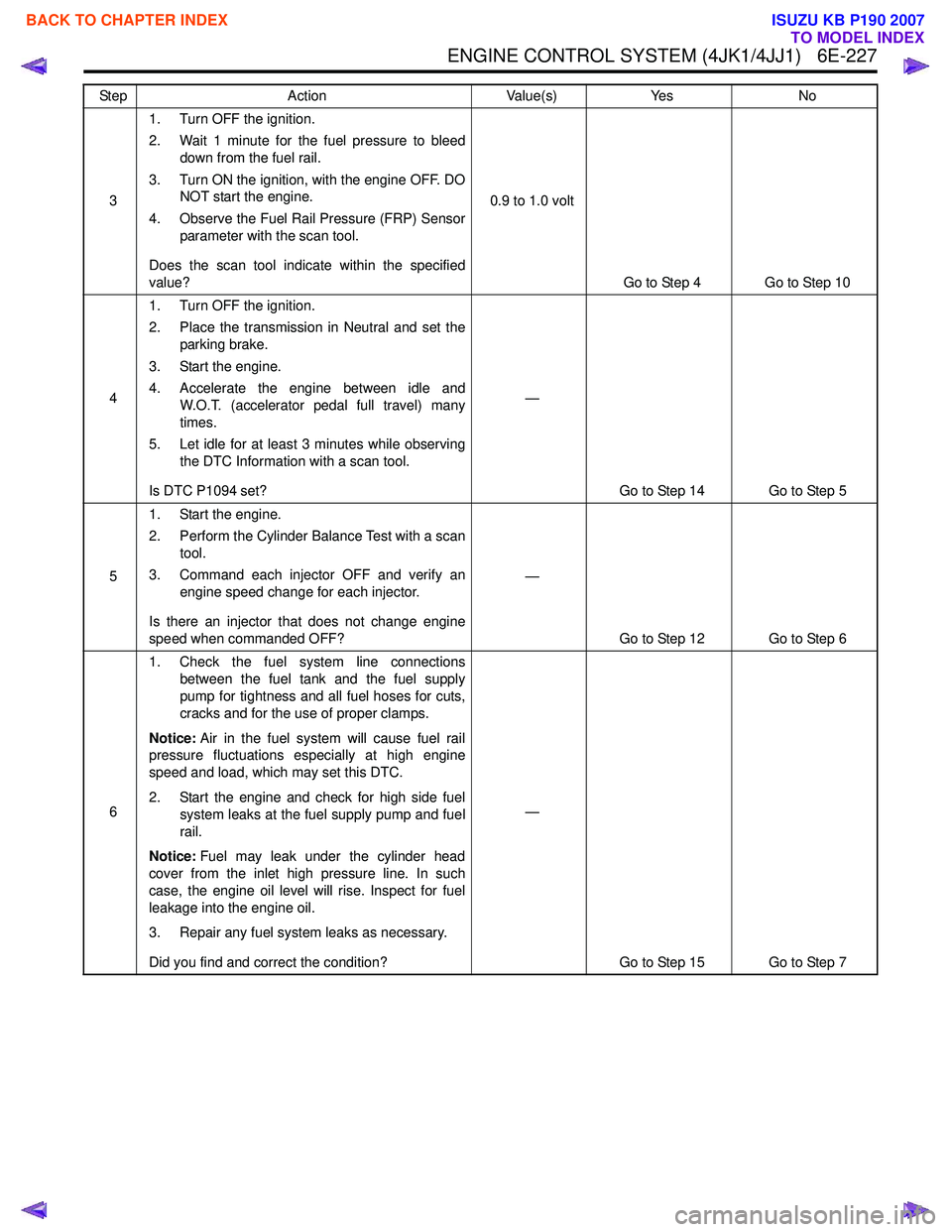
ENGINE CONTROL SYSTEM (4JK1/4JJ1) 6E-227
31. Turn OFF the ignition.
2. Wait 1 minute for the fuel pressure to bleed down from the fuel rail.
3. Turn ON the ignition, with the engine OFF. DO NOT start the engine.
4. Observe the Fuel Rail Pressure (FRP) Sensor parameter with the scan tool.
Does the scan tool indicate within the specified
value? 0.9 to 1.0 volt
Go to Step 4 Go to Step 10
4 1. Turn OFF the ignition.
2. Place the transmission in Neutral and set the parking brake.
3. Start the engine.
4. Accelerate the engine between idle and W.O.T. (accelerator pedal full travel) many
times.
5. Let idle for at least 3 minutes while observing the DTC Information with a scan tool.
Is DTC P1094 set? —
Go to Step 14 Go to Step 5
5 1. Start the engine.
2. Perform the Cylinder Balance Test with a scan tool.
3. Command each injector OFF and verify an engine speed change for each injector.
Is there an injector that does not change engine
speed when commanded OFF? —
Go to Step 12 Go to Step 6
6 1. Check the fuel system line connections
between the fuel tank and the fuel supply
pump for tightness and all fuel hoses for cuts,
cracks and for the use of proper clamps.
Notice: Air in the fuel system will cause fuel rail
pressure fluctuations especially at high engine
speed and load, which may set this DTC.
2. Start the engine and check for high side fuel system leaks at the fuel supply pump and fuel
rail.
Notice: Fuel may leak under the cylinder head
cover from the inlet high pressure line. In such
case, the engine oil level will rise. Inspect for fuel
leakage into the engine oil.
3. Repair any fuel system leaks as necessary.
Did you find and correct the condition? —
Go to Step 15 Go to Step 7
Step
Action Value(s)Yes No
BACK TO CHAPTER INDEX
TO MODEL INDEX
ISUZU KB P190 2007
Page 1849 of 6020
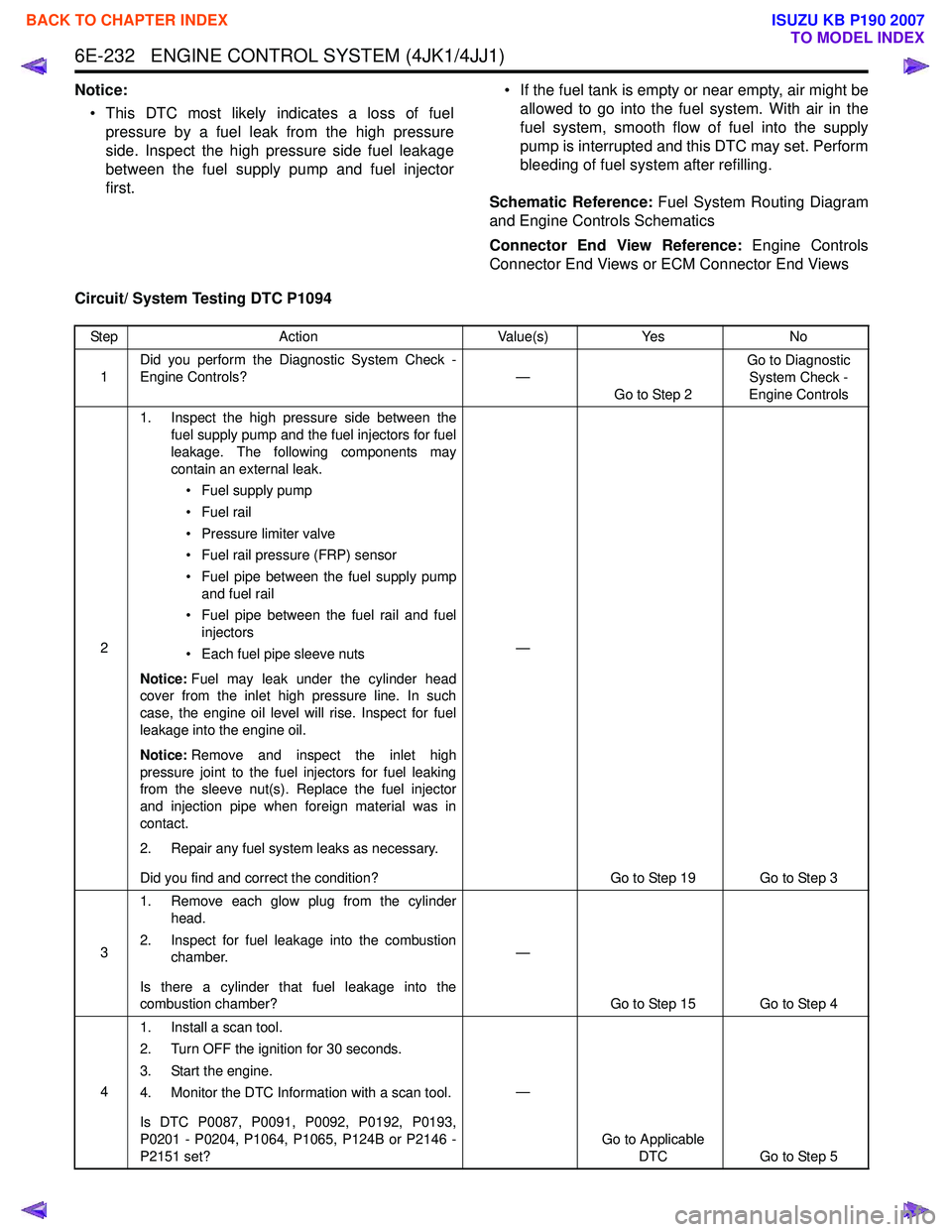
6E-232 ENGINE CONTROL SYSTEM (4JK1/4JJ1)
Notice:• This DTC most likely indicates a loss of fuel pressure by a fuel leak from the high pressure
side. Inspect the high pressure side fuel leakage
between the fuel supply pump and fuel injector
first. • If the fuel tank is empty or near empty, air might be
allowed to go into the fuel system. With air in the
fuel system, smooth flow of fuel into the supply
pump is interrupted and this DTC may set. Perform
bleeding of fuel system after refilling.
Schematic Reference: Fuel System Routing Diagram
and Engine Controls Schematics
Connector End View Reference: Engine Controls
Connector End Views or ECM Connector End Views
Circuit/ System Testing DTC P1094
Step Action Value(s)Yes No
1 Did you perform the Diagnostic System Check -
Engine Controls? —
Go to Step 2 Go to Diagnostic
System Check -
Engine Controls
2 1. Inspect the high pressure side between the
fuel supply pump and the fuel injectors for fuel
leakage. The following components may
contain an external leak.
• Fuel supply pump
• Fuel rail
• Pressure limiter valve
• Fuel rail pressure (FRP) sensor
• Fuel pipe between the fuel supply pump and fuel rail
• Fuel pipe between the fuel rail and fuel injectors
• Each fuel pipe sleeve nuts
Notice: Fuel may leak under the cylinder head
cover from the inlet high pressure line. In such
case, the engine oil level will rise. Inspect for fuel
leakage into the engine oil.
Notice: Remove and inspect the inlet high
pressure joint to the fuel injectors for fuel leaking
from the sleeve nut(s). Replace the fuel injector
and injection pipe when foreign material was in
contact.
2. Repair any fuel system leaks as necessary.
Did you find and correct the condition? —
Go to Step 19 Go to Step 3
3 1. Remove each glow plug from the cylinder
head.
2. Inspect for fuel leakage into the combustion chamber.
Is there a cylinder that fuel leakage into the
combustion chamber? —
Go to Step 15 Go to Step 4
4 1. Install a scan tool.
2. Turn OFF the ignition for 30 seconds.
3. Start the engine.
4. Monitor the DTC Information with a scan tool.
Is DTC P0087, P0091, P0092, P0192, P0193,
P0201 - P0204, P1064, P1065, P124B or P2146 -
P2151 set? —
Go to Applicable DTC Go to Step 5
BACK TO CHAPTER INDEX
TO MODEL INDEX
ISUZU KB P190 2007